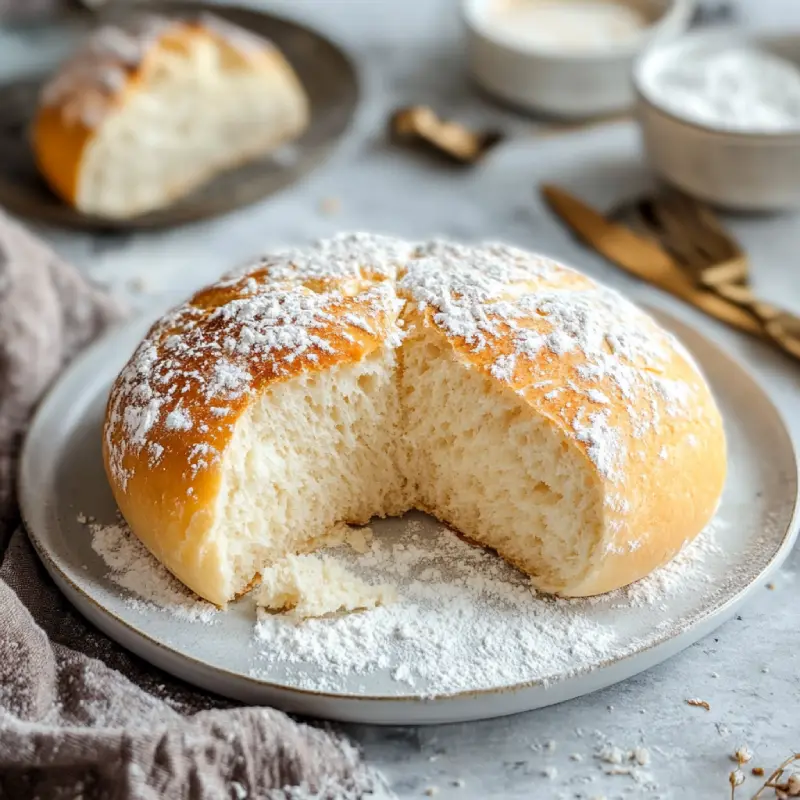1. Introduction to Self-Rising Flour
Self-rising flour is a type of flour that contains baking powder and salt, making it a convenient ingredient for quick baking. This combination eliminates the need to add leavening agents separately, making it an excellent choice for beginner bakers.
Self-rising flour was originally developed in the 19th century by an English baker to simplify the baking process and provide more consistent results. It has since become a staple in many kitchens, especially in the southern United States, where it’s commonly used for biscuits and other classic baked goods.
Using self-rising flour offers several benefits, such as saving time and reducing the number of ingredients needed for a recipe. It’s perfect for creating biscuits, pancakes, and cakes without worrying about exact measurements of leavening agents.
2. How to Make Self-Rising Flour at Home
If you don’t have self-rising flour on hand, you can easily make it yourself with just three simple ingredients:
- 1 cup all-purpose flour
- 1 1/2 teaspoons baking powder
- 1/4 teaspoon salt
To create your own self-rising flour, simply whisk together the all-purpose flour, baking powder, and salt until well combined. This mixture can be used in place of store-bought self-rising flour in any recipe.
For best results, store your homemade self-rising flour in an airtight container in a cool, dry place. This will help maintain the potency of the baking powder and keep your flour fresh for up to three months.
3. Baking with Self-Rising Flour: Tips & Tricks
Self-rising flour is different from all-purpose flour because it already contains baking powder and salt. This makes it ideal for recipes that require a quick rise, such as biscuits, pancakes, and muffins. However, it’s important not to use self-rising flour in recipes that call for additional leavening agents, as this can result in an overly risen or dense texture.
Use self-rising flour in recipes that specifically call for it, or substitute it for all-purpose flour by omitting the added salt and leavening agents. One common mistake is using self-rising flour in yeast-based recipes, which can lead to inconsistent results.
Another tip is to avoid overmixing the batter when using self-rising flour. Overmixing can cause the gluten in the flour to overdevelop, resulting in a tougher texture.
4. Essential Baking Tools
To get the best results when baking with self-rising flour, it’s important to have the right tools on hand. Here are some essential baking tools that will make your baking experience easier and more enjoyable:
- Mixing Bowls: A set of different-sized mixing bowls is essential for combining wet and dry ingredients.
- Measuring Cups and Spoons: Accurate measurements are crucial for ensuring your baked goods turn out perfectly.
- Spatulas: Silicone spatulas are great for scraping down the sides of bowls and folding ingredients together gently.
- Whisk: A whisk helps evenly distribute the baking powder and salt throughout the flour.
- Pastry Cutter: This tool is useful for cutting butter into flour when making biscuits or other pastries.
These tools will help ensure that your self-rising flour recipes come out light, fluffy, and delicious every time.
5. Breakfast Recipes with Self-Rising Flour
5.1 Fluffy Pancakes
Start your morning with these fluffy pancakes made with just five simple ingredients: self-rising flour, milk, eggs, sugar, and butter. Self-rising flour makes these pancakes rise beautifully without any additional leavening agents.
Ingredients:
1 cup self-rising flour
1 tablespoon sugar
1 egg
1 cup milk
2 tablespoons melted butter
Instructions:
In a mixing bowl, combine self-rising flour, sugar, egg, and milk.
Whisk until just combined (don’t overmix to avoid dense pancakes).
Let the batter rest for 5 minutes before cooking for a light and fluffy texture.
For more pancake-making tips, visit Lynn’s Way of Life.
5.2 Classic Biscuits
These classic biscuits are perfect for any meal. The use of self-rising flour ensures they rise well, creating a light, flaky texture.
Ingredients:
2 cups self-rising flour
1/2 cup cold butter, cubed
3/4 cup milk
Instructions:
Preheat your oven to 450°F.
In a mixing bowl, cut the cold butter into the self-rising flour until it resembles coarse crumbs.
Add the milk and stir until just combined.
Turn the dough onto a floured surface, knead lightly, and cut out biscuits.
Variations include adding cheese or fresh herbs for extra flavor. For more biscuit ideas, visit Baker Bettie.
5.3 Waffles with Self-Rising Flour
Create crispy and golden waffles with self-rising flour. This easy recipe is perfect for a quick breakfast or brunch.
Ingredients:
1 1/2 cups self-rising flour
2 eggs
1 cup milk
1/4 cup melted butter
Instructions:
Combine all ingredients in a mixing bowl.
Pour batter into a preheated waffle iron and cook until golden.
Find more breakfast inspiration at King Arthur Baking.
6. Sweet Treats: Cakes and Muffins
6.1 Cinnamon Muffins
These cinnamon sugar-coated muffins are tender and flavorful, thanks to the use of self-rising flour.
Ingredients:
2 cups self-rising flour
1 cup sugar
1/2 cup melted butter
1 cup milk
1 teaspoon cinnamon
Instructions:
Preheat oven to 375°F. In a bowl, mix self-rising flour, sugar, and cinnamon.
Stir in melted butter and milk until just combined.
Scoop batter into muffin tins and bake for 20 minutes.
To keep muffins moist, avoid overmixing and add a touch of yogurt. For more, visit Boston Girl Bakes.
6.2 Chocolate Chip Cookies (150 words)
These chocolate chip cookies made with self-rising flour are easy to prepare and deliver soft, chewy centers with crisp edges.
Ingredients:
2 cups self-rising flour
1 cup butter, softened
1 cup brown sugar
1/2 cup granulated sugar
1 egg
1 cup chocolate chips
Instructions:
Preheat oven to 350°F. Cream butter and sugars together until light.
Add egg and mix well. Gradually add self-rising flour and mix until incorporated.
Fold in chocolate chips and scoop onto baking sheets.
Find more cookie recipes at Tasty & Healthy Recipes.
6.3 Classic Yellow Cake
This classic yellow cake is moist and tender, perfect for any occasion. The use of self-rising flour ensures a consistent rise.
Ingredients:
2 cups self-rising flour
1 1/2 cups sugar
1/2 cup butter, softened
3 eggs
1 cup milk
1 teaspoon vanilla extract
Instructions:
Preheat oven to 350°F. Cream butter and sugar together until fluffy.
Add eggs one at a time, then mix in vanilla.
Gradually add self-rising flour alternately with milk, mixing just until smooth.
Pour batter into a greased cake pan and bake for 30-35 minutes.
For frosting ideas, visit King Arthur Baking.
9. Gluten-Free and Vegan Baking with Self-Rising Flour
If you’re looking for gluten-free options, you can easily create a gluten-free version of self-rising flour. Simply use a gluten-free all-purpose flour blend in place of regular flour, and add 1 1/2 teaspoons of baking powder and 1/4 teaspoon of salt per cup of flour. This allows you to enjoy your favorite baked goods without gluten.
For vegan substitutions, replace traditional ingredients like butter, milk, and eggs with vegan-friendly options. Use plant-based butter or coconut oil instead of butter, almond milk or oat milk for regular milk, and flax eggs (1 tablespoon ground flaxseed mixed with 3 tablespoons water) as an egg replacement. These substitutions work well in many self-rising flour recipes, such as pancakes and muffins.
For more gluten-free and vegan recipes, explore popular options like gluten-free pancakes or vegan muffins. These delicious treats ensure everyone can enjoy baking, regardless of dietary preferences.
10. FAQs About Self-Rising Flour
Can I substitute self-rising flour for all-purpose flour?
Yes, you can substitute self-rising flour for all-purpose flour, but you’ll need to make some adjustments. Since self-rising flour already contains baking powder and salt, you should omit any additional leavening agents and salt from the recipe to avoid over-rising or an overly salty flavor.
What is the shelf life of self-rising flour?
The shelf life of self-rising flour depends on how well it is stored. For the best results, store it in an airtight container in a cool, dry place to maintain freshness. Properly stored, self-rising flour can last up to six months.
Can I make my own self-rising flour?
Absolutely! To make your own self-rising flour, combine 1 cup of all-purpose flour with 1 1/2 teaspoons of baking powder and 1/2 teaspoon of salt. Mix well, and you’ll have a ready-to-use self-rising flour substitute that works in most recipes.
What if my recipe calls for baking powder but I only have self-rising flour?
If your recipe calls for baking powder but you only have self-rising flour, you can still make it work. Just adjust other ingredients to avoid adding extra leavening. Since self-rising flour already has baking powder, omit any additional baking powder in the recipe to prevent over-leavening.
11. Conclusion and Final Tips
Self-rising flour is an incredibly versatile ingredient that simplifies the baking process and delivers consistent results. From fluffy pancakes and biscuits to cakes and muffins, self-rising flour is perfect for creating a wide variety of baked goods without the need for extra leavening agents.
Experimenting with different recipes and flavor combinations is one of the best parts of using self-rising flour. Whether you prefer sweet treats or savory dishes, there are countless possibilities to explore. Try adding fruits, spices, or herbs to enhance the flavor of your baked goods.
For the best results when baking with self-rising flour, be sure to measure your ingredients accurately and adjust for humidity when necessary. Proper storage of your flour will also ensure that your baked creations turn out perfectly every time. So grab your mixing bowl, and start experimenting with the many ways you can use self-rising flour in your kitchen!

